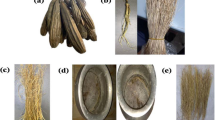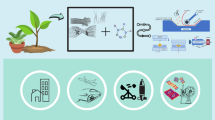Abstract
The desired features of the green composite materials including the low cost, environmentally friendly and degradation characteristics have made them very suitable for wide industrial applications. However, wide extensive investigations about various agro waste fibers are still required to expand the utilization of such fibers into green materials to enhance the overall desired properties of green composites. Thus, in this work, investigations of the effects of fiber loading of olive fibers in the low density polyethylene (LDPE) green composites were carried out. The overall bio-composite flexural properties and rupture stress under impact environment were studied. All of the applied force, flexural strain, flexural strength, flexural moduli and maximum stress at fracture under impact environment of various designed composites were studied to determine the optimal reinforcing conditions of such green composites. Various composites with different fiber loading (20 wt%, 30 wt%, 40 wt%, and 50 wt%) were designed and fabricated to investigate the effect of fibers on the considered properties of the composites. Results have revealed the optimum reinforcing conditions to enhance the overall flexural property of the composites. The maximum flexural strength of the green bio-composites with various fiber loadings was found at the 40 wt% fiber content case with 34.6 MPa. It was also shown that both 30 wt% and 40 wt% fiber loading cases had the highest flexural moduli of more than 800 MPa. All of flexural strength, flexural modulus and impact rupture stress properties were dramatically enhanced with fiber loading up to 40 wt%, but decreased after that due to agglomeration of fibers. Moreover, olive fibers were capable of improving the flexural modulus of LDPE of more than 200%.








Similar content being viewed by others
References
Zini E, Scandola M (2011) Green composites: an overview. Polym Compos 32(12):1905–1915
Thakur VK, Ding G, Ma J, Lee PS, Lu X (2012) Hybrid materials and polymer electrolytes for electrochromic device applications. Adv Mat 24(30):4071–4096
AL-Oqla FM (2017) Investigating the mechanical performance deterioration of Mediterranean cellulosic cypress and pine/polyethylene composites. Cellulose 24(6):2523–2530
Fares O, AL-Oqla FM, Hayajneh MT, (2019) Dielectric relaxation of Mediterranean lignocellulosic fibers for sustainable functional biomaterials. Mater Chem Phys 229:174–182
AL-Oqla FM, Salit MS, (2017) Materials selection for natural fiber composites. WoodHead Publishing, Cambridge
Lagel M, Hai L, Pizzi A, Basso M, Delmotte L, Abdalla S, Zahed A, Al-Marzouki F (2016) Automotive brake pads made with a bioresin matrix. Ind Crops Prod 85:372–381
AL-Oqla FM, El-Shekeil Y (2019) Investigating and predicting the performance deteriorations and trends of polyurethane bio-composites for more realistic sustainable design possibilities. J Cleaner Prod 222:865–870
AL-Oqla FM, Sapuan S (2017) Investigating the inherent characteristic/performance deterioration interactions of natural fibers in bio-composites for better utilization of resources. J Polym Environ 26(3):1–7
Almagableh A, AL-Oqla FM, Omari MA (2017) Predicting the effect of nano-structural parameters on the elastic properties of carbon nanotube-polymeric based composites. Int J Perform Eng 13(1):73
AL-Oqla FM, Omar AA, Fares O (2018) Evaluating sustainable energy harvesting systems for human implantable sensors. Int J Electron 105(3):504–517
AL-Oqla FM, Alothman OY, Jawaid M, Sapuan S, Es-Saheb M (2014) Processing and properties of date palm fibers and its composites. Biomass Bioenergy. Springer, Cham, pp 1–25
Yan F, Lin Z, Wang X, Azarmi F, Sobolev K (2017) Evaluation and prediction of bond strength of GFRP-bar reinforced concrete using artificial neural network optimized with genetic algorithm. Compos Struct 161:441–452
Bhatti HN, Safa Y, Yakout SM, Shair OH, Iqbal M, Nazir A (2020) Efficient removal of dyes using carboxymethyl cellulose/alginate/polyvinyl alcohol/rice husk composite: adsorption/desorption, kinetics and recycling studies. Int JBioMacro 150:861–870
Kausar A, Naeem K, Hussain T, Bhatti HN, Jubeen F, Nazir A, Iqbal M (2019) Preparation and characterization of chitosan/clay composite for direct Rose FRN dye removal from aqueous media: comparison of linear and non-linear regression methods. J Mater Res Technol 8(1):1161–1174
Agoudjil B, Benchabane A, Boudenne A, Ibos L, Fois M (2011) Renewable materials to reduce building heat loss: characterization of date palm wood. Energy Build 43(2):491–497
AL-Oqla FM, Salit MS (2017) Material selection of natural fiber composites using the analytical hierarchy process. Woodhead Publishing, Elsevier, Cambridge, pp 169–234
Ishtiaq F, Bhatti HN, Khan A, Iqbal M, Kausar A (2020) Polypyrole, polyaniline and sodium alginate biocomposites and adsorption-desorption efficiency for imidacloprid insecticide. Int JBioMacro 147:217–232
Al-Oqla FM, Omar AA (2012) A decision-making model for selecting the GSM mobile phone antenna in the design phase to increase over all performance. Prog Electromagn Res 25:249–269. https://doi.org/10.2528/PIERC11102702
Al-Oqla FM, Omar AA (2015) An expert-based model for selecting the most suitable substrate material type for antenna circuits. Int J Electron 102(6):1044–1055
Aridi N, Sapuan S, Zainudin E, AL-Oqla FM (2016) Mechanical and morphological properties of injection-molded rice husk polypropylene composites. Int J Polym Anal Charact 21(4):305–313
Asim M, Jawaid M, Abdan K, Ishak M (2018) The effect of silane treated fibre loading on mechanical properties of pineapple leaf/kenaf fibre filler phenolic composites. J Polym Environ 26(4):1520–1527
AL-Oqla FM, Salit MS, (2017) Natural fiber composites. Woodhead Publishing, Cambridge, pp 23–48
Sapuan S, Haniffah W, AL-Oqla FM (2016) Effects of reinforcing elements on the performance of laser transmission welding process in polymer composites: a systematic review. Int J Perform Eng 12(6):553
Aridi N, Sapuan S, Zainudin E, AL-Oqla FM (2017) A review of rice husk bio-based composites. Curr Org Synth 14(2):263–271
Alshammari BA, Alotaibi MD, Alothman OY, Sanjay M, Kian LK, Almutairi Z, Jawaid M (2019) A new study on characterization and properties of natural fibers obtained from olive tree (Olea europaea L.) residues. J Polym Environ 27(11):2334–2340
Shah DU (2014) Natural fibre composites: comprehensive Ashby-type materials selection charts. Mater Des 62:21–31
AL-Oqla FM, Hayajneh MT (2007) A design decision-making support model for selecting suitable product color to increase probability. Paper presented at the Design Challenge Conference: Managing Creativity, Innovation, and Entrepreneurship, Amman, Jordan,
AL-Oqla FM, Sapuan S, Anwer T, Jawaid M, Hoque M (2015) Natural fiber reinforced conductive polymer composites as functional materials: a review. Synth Met 206:42–54
AL-Oqla FM, Sapuan S, Ishak M, Nuraini A (2015) A model for evaluating and determining the most appropriate polymer matrix type for natural fiber composites. Int J Polym Anal Charact 20(just-accepted):191–205
AL-Oqla FM, Sapuan S, Ishak MR, Nuraini AA (2014) A novel evaluation tool for enhancing the selection of natural fibers for polymeric composites based on fiber moisture content criterion. BioResources 10(1):299–312
Al-Widyan MI, Al-Oqla FM (2011) Utilization of supplementary energy sources for cooling in hot arid regions via decision-making model. Int J Eng Res Appl 1(4):1610–1622
Al-Widyan MI, Al-Oqla FM (2014) Selecting the most appropriate corrective actions for energy saving in existing buildings A/C in hot arid regions. Build Simul 7(5):537–545. https://doi.org/10.1007/s12273-013-0170-3
Zhang K, Wang F, Liang W, Wang Z, Duan Z, Yang B (2018) Thermal and mechanical properties of bamboo fiber reinforced epoxy composites. Polymers 10(6):608
El-Shekeil Y, Sapuan S, Abdan K, Zainudin E (2012) Influence of fiber content on the mechanical and thermal properties of Kenaf fiber reinforced thermoplastic polyurethane composites. Mater Des 40:299–303
El-Shekeil Y, AL-Oqla F, Sapuan S (2019) Performance tendency and morphological investigations of lignocellulosic tea/polyurethane bio-composite materials. Polym Bull 1–14
Noreen S, Bhatti HN, Iqbal M, Hussain F, Sarim FM (2020) Chitosan, starch, polyaniline and polypyrrole biocomposite with sugarcane bagasse for the efficient removal of Acid Black dye. Int JBioMacro 147:439–452
AL-Oqla FM, Sapuan S, Ishak MR, Nuraini A (2016) A decision-making model for selecting the most appropriate natural fiber–Polypropylene-based composites for automotive applications. J Compos Mater 50(4):543–556
Author information
Authors and Affiliations
Corresponding author
Additional information
Publisher's Note
Springer Nature remains neutral with regard to jurisdictional claims in published maps and institutional affiliations.
Rights and permissions
About this article
Cite this article
AL-Oqla, F.M. Flexural Characteristics and Impact Rupture Stress Investigations of Sustainable Green Olive Leaves Bio-composite Materials. J Polym Environ 29, 892–899 (2021). https://doi.org/10.1007/s10924-020-01889-3
Accepted:
Published:
Issue Date:
DOI: https://doi.org/10.1007/s10924-020-01889-3




